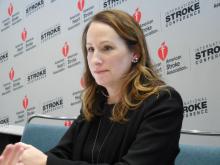LOS ANGELES – When a panel organized by the American Heart Association’s Stroke Council recently revised the group’s guideline for early management of acute ischemic stroke, they were clear on the overarching change they had to make: Incorporate recent evidence collected in two trials that established brain imaging as the way to identify patients eligible for clot removal treatment by thrombectomy, a change in practice that has made this outcome-altering intervention available to more patients.
“The major take-home message [of the new guideline] is the extension of the time window for treating acute ischemic stroke,” said William J. Powers, MD, chair of the guideline group (Stroke. 2018 Jan 24. doi: 10.1161/STR.0000000000000158).
Based on recently reported results from the DAWN (N Engl J Med. 2018;378[1]:11-21) and DEFUSE 3 (N Engl J Med. 2018 Jan 24. doi: 10.1056/NEJMoa1713973) trials “we know that there are patients out to 24 hours from their stroke onset who may benefit” from thrombectomy. “This is a major, major change in how we view care for patients with stroke,” Dr. Powers said in a video interview. “Now there’s much more time. Ideally, we’ll see smaller hospitals develop the ability to do the imaging” that makes it possible to select acute ischemic stroke patients eligible for thrombectomy despite a delay of up to 24 hours from their stroke onset to the time of thrombectomy, said Dr. Powers, professor and chair of neurology at the University of North Carolina, Chapel Hill.
The big priority for the stroke community now that this major change in patient selection was incorporated into a U.S. practice guideline will be acting quickly to implement the steps needed to make this change happen, Dr. Powers and others said.
“The 2015 thrombectomy trials were a big step forward, but we’ve still been constrained by the time window. Allowing treatment out to 24 hours is a tremendous advance,” commented Karen Furie, MD, professor and chair of neurology at Brown University in Providence, R.I., who coauthored an editorial that accompanied the new guideline (Stroke. 2018 Jan 24. doi: 10.1161/STROKEAHA.118.020176). “This radically changes how we approach patients with stroke. It’s a major step forward,” but it also means “a lot of collaboration and thinking through systems of care” to try to implement what the guideline now calls for, she said in an interview. “You need a protocol and to have people look for” the patients who meet the new imaging criterion for receiving thrombectomy. But the stroke community has recently been readying for this moment. People are poised to act on this very quickly,” Dr. Furie said.The new guideline will mean “changes in process and systems of care,” agreed Jeffrey L. Saver, MD, professor of neurology and director of the stroke unit at the University of California, Los Angeles. The imaging called for “will be practical at some primary stroke centers but not others,” he said, although most hospitals certified to provide stroke care as primary stroke centers or acute stroke–ready hospitals have a CT scanner that could provide the basic imaging needed to assess many patients. (CT angiography and perfusion CT are more informative for determining thrombectomy eligibility.) But interpretation of the brain images to distinguish patients eligible for thrombectomy from those who aren’t will likely happen at comprehensive stroke centers that perform thrombectomy or by experts using remote image reading.
The new guideline will also require changes in the algorithms emergency medicine technicians use to decide where to transport a stroke patient, and improvements in the systems that transport patients from smaller hospitals that do imaging to larger centers that perform thrombectomy, Dr. Saver said. “The current system is terrible at making that transfer. We need to improve door-in/door-out time. It’s been done for patients with ST-elevation MI, and now it must be done for stroke patients.”Dr. Saver expects that the new guideline will translate most quickly into changes in the imaging and transfer protocols that the Joint Commission may now require from hospitals certified as primary stroke centers or acute stroke-ready hospitals, changes that could be in place sometime later in 2018, he predicted. These are steps “that would really help drive system change.”
Dr. Powers and Dr. Furie had no disclosures. Dr. Saver has received research support and personal fees from Medtronic-Abbott and Neuravia.


